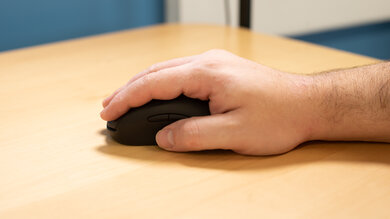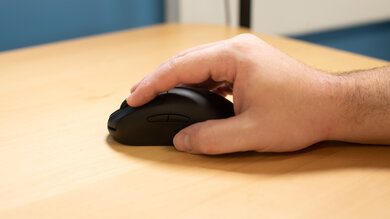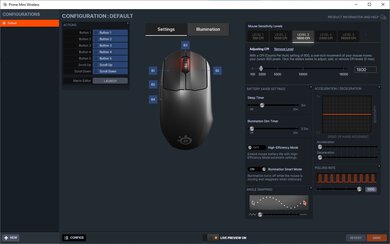The SteelSeries Prime Mini Wireless is a wireless gaming mouse with a solid, matte plastic body covered in a tactile surface finish. It has two buttons on the left side, an RGB lighting zone in the scroll wheel, and a button on the underside that cycles through CPI settings. Its right-handed shape is suitable for smaller-sized hands using a palm grip and small to large-sized hands using a claw or fingertip grip. However, it isn't suitable for extra-large hands using any grip type. Performance-wise, it has a low lift-off distance, and you can adjust the CPI by steps of 100 within a very wide range. It also has good click latency that will be sufficient for most users, but it's somewhat higher than most other high-end gaming mice.
Our Verdict
The SteelSeries Prime Mini Wireless is very good for office and multimedia work. It feels very well-built and has a comfortable, right-handed shape suitable for all grip types and most hand sizes. You can also connect it wirelessly with its USB receiver, and you can program all the buttons on the top of the mouse using the customization software. Unfortunately, there's no Bluetooth support, and the mouse wheel lacks L/R tilt buttons and a free-scrolling mode.
-
Feels very well-built.
-
Connects wirelessly with its USB receiver.
-
Customization software compatible with Windows and macOS.
-
Mouse wheel lacks L/R tilt buttons and a free-scrolling mode.
-
No Bluetooth support.
The SteelSeries Prime Mini Wireless is a great FPS gaming mouse. It's fairly lightweight and feels very well-built. It also has a comfortable, right-handed shape suitable for all grip types and most hand sizes; however, it isn't suitable for extra-large hands using any grip type. Performance-wise, it has a very low minimum lift-off distance, and you can adjust the CPI by increments of 100 within a very wide range. It also has good click latency, though it isn't as good as some premium gaming mice, and gamers who play competitive or reaction-based games may prefer a more responsive-feeling option.
-
Feels very well-built.
-
Fairly lightweight.
-
Mouse feet glide very smoothly on desks and mousepads.
-
CPI button is on the bottom of the mouse, making on-the-fly changes awkward.
The SteelSeries Prime Mini Wireless is good for MMO gaming, but it doesn't have nearly as many side buttons as a dedicated MMO gaming mouse. That said, it feels very well-built, and you can program all of the buttons on the top of the mouse using the customization software. Its right-handed shape is suitable for all grip types and most hand sizes; however, it isn't suitable for extra-large hands using any grip type. It also has good click latency and a very low minimum lift-off distance. Unfortunately, you can only adjust the CPI by increments of 100, which may be disappointing to some.
-
Feels very well-built.
-
Mouse feet glide very smoothly on desks and mousepads.
-
Customization software compatible with Windows and macOS.
-
Not nearly as many side buttons as a dedicated MMO gaming mouse.
-
CPI button is on the bottom of the mouse, making on-the-fly changes awkward.
The SteelSeries Prime Mini Wireless is an impressive ultra-light gaming mouse that's fairly lightweight and feels very well-built. It has a comfortable, right-handed shape suitable for all grip types and most hand sizes and mouse feet that glide very smoothly on mousepads and desks. Performance-wise, it has a very low lift-off distance, and you can adjust the CPI by increments of 100 within a wide range. It also has good click latency, though it's not as low as other premium gaming mice.
-
Feels very well-built.
-
Fairly lightweight.
-
Mouse feet glide very smoothly on desks and mousepads.
-
CPI button is on the bottom of the mouse, making on-the-fly changes awkward.
The SteelSeries Prime Mini Wireless is decent for travel, but it's bulky and may not fit in most laptop cases. That said, it connects wirelessly with its USB receiver, and it feels very sturdy. It also has a comfortable, right-handed shape suitable for all grip types and most hand sizes. Unfortunately, it doesn't have a storage compartment for its USB receiver, and it doesn't support Bluetooth.
-
Feels very well-built.
-
Connects wirelessly with its USB receiver.
-
Bulky; may not fit in most laptop cases.
-
No Bluetooth support.
- 7.9 Office/Multimedia
- 8.3 Video Games (FPS)
- 7.9 Video Games (MMO)
- 8.4 Ultra-Light Gaming
- 6.9 Travel
Changelog
- Updated Oct 28, 2021: Review published.
- Updated Oct 22, 2021: Early access published.
- Updated Oct 18, 2021: Our testers have started testing this product.
- Updated Oct 14, 2021: The product has arrived in our lab, and our testers will start evaluating it soon.
- Updated Oct 10, 2021: We've purchased the product and are waiting for it to arrive in our lab.
Check Price
Differences Between Sizes And Variants
The SteelSeries Prime Mini Wireless belongs to a lineup of SteelSeries mice that share a similar shape and collection of features. The SteelSeries Prime is the base version and a larger, wired version of this mouse. While not a variant, this mouse also has a wired version, the SteelSeries Prime Mini. The unit we tested is black, and there are no other color variants. You can see the label for our unit here.
Popular Mice Comparisons
The SteelSeries Prime Mini Wireless is an impressive, lightweight FPS gaming mouse and a wireless version of the SteelSeries Prime Mini. While it doesn't have some of the more exotic features like OLED screens or multiple lift-off distance sensors like some of the other models in the SteelSeries Prime lineup, it's lightweight, better suited for smaller hands, and connects wirelessly with its USB receiver. It also has the same optical magnetic switches as the other Prime models. SteelSeries claims these switches provide faster and more consistent clicks and that they have longer lifespans due to their having fewer mechanical components compared to traditional mechanical switches. Overall, this mouse is a great choice if you're a fan of the SteelSeries Prime series but are looking for a wireless option and have smaller-sized hands.
For more recommendations, check out our picks for the best wired mice, the best gaming mice, and the best SteelSeries mice.
The SteelSeries Prime Mini Wireless is a scaled-down version of the SteelSeries Prime Wireless. The Mini Wireless is somewhat lighter and has a lower lift-off distance. It also has marginally lower click latency. Both mice are suitable for all grip types and most hand sizes, but the Prime Wireless is better suited for larger hands, while the Mini Wireless is more accommodating to smaller-sized hands.
The SteelSeries Prime Mini Wireless is an impressive wireless gaming mouse, while the BenQ ZOWIE EC2 is a very good wired gaming mouse. The SteelSeries is lighter and feels sturdier. It also has mouse feet that glide more smoothly and, despite being a wireless mouse, has a more flexible charging cable. Performance-wise, it has a much wider CPI range and a lower lift-off distance. It also has customization software compatible with Windows and macOS, which the BenQ lacks. On the other hand, the BenQ has a more consistent sensor and somewhat lower click latency, but it only has four default CPI presets.
The GLORIOUS Model D is an excellent wired ultra-lightweight gaming mouse, while the SteelSeries Prime Mini Wireless is an impressive wireless ultra-lightweight gaming mouse. The GLORIOUS is a bit lighter and has lower click latency. On the other hand, the SteelSeries has a wider CPI range and lower lift-off distance. It also has customization software compatible with Windows and macOS, while the GLORIOUS software is only compatible with Windows. Both mice have right-handed shapes suitable for all grip types and most hand sizes, but the GLORIOUS is better-suited for larger hands, while the SteelSeries is more accommodating for smaller hands.
The Logitech G PRO X SUPERLIGHT and the SteelSeries Prime Mini Wireless are both ultra-lightweight, wireless gaming mice, but the Logitech performs better overall. The Logitech is significantly lighter and has mouse feet that glide more smoothly. It also has a higher maximum CPI range, a more precisely adjustable CPI, a more consistent sensor, and significantly lower click latency. On the other hand, the SteelSeries has a more flexible charging cable with a USB-C connector, while the Logitech cable has an older micro-USB connector. The SteelSeries also has RGB lighting, which the Logitech lacks.
Test Results
The SteelSeries Prime Mini Wireless has a straightforward, conventional design and looks identical to the SteelSeries Prime Mini. It has a subtle logo on the palm rest and a single RGB lighting zone in the scroll wheel.
If you're interested in a lighter mouse, check out the Cooler Master MM731.
The SteelSeries Prime Mini Wireless feels very solid. There's no rattling when you shake the mouse, the buttons offer very satisfying tactile feedback, and there isn't any flexibility when you squeeze into the body. Additionally, the underside of the mouse doesn't flex as it does on the SteelSeries Prime Mini.
The SteelSeries Prime Mini Wireless retains the same comfortable, right-handed shape profile as the SteelSeries Prime but scaled-down, making it more suitable for smaller hands. It also has the same textured plastic surface finish as the full-sized version. SteelSeries calls this surface a "VD130 tactile microtexture body," which refers to its surface finish rating standard set forth by the Society of German Engineers.
SteelSeries advertises the battery on the SteelSeries Prime Mini Wireless lasts for 100 hours at a 1000Hz polling rate. You can set the mouse to a high-efficiency battery mode using the software. This mode restricts certain customizable settings in the software, turns off all RGB lighting, and locks the polling rate to 125Hz.
The SteelSeries Prime Mini Wireless' charging cable feels like it's very good quality, but it isn't as flexible as some paracord-like cables we've tested. It also retains some slight kinks from its packaging.
The mouse feet on the SteelSeries Prime Mini Wireless glide very smoothly on hard or soft mousepads and desks. However, they do produce a slight scratching sound when used directly on desks. The feet are identical to those on the SteelSeries Prime Wireless and the SteelSeries Prime Mini, but they're higher quality, virgin-grade PTFE than the full-size SteelSeries Prime we tested, which has regular PTFE feet.
The polling rate settings available on the SteelSeries Prime Mini Wireless are 125Hz, 250Hz, 500Hz, and 1000Hz. You can also cycle between five custom CPI settings using the dedicated button on the underside of the mouse. Unfortunately, you can't adjust the CPI as precisely as you can on the SteelSeries Prime Mini. Also, the sensor on our unit is a bit inconsistent, overshooting the set CPI by 0.72% during slower cursor movements and undershooting by 7.04% during fast cursor movements.
You can program all of the buttons on the top of the SteelSeries Prime Mini Wireless, including the scroll up/down inputs. There's an unlabeled button on the bottom of the mouse that cycles between CPI settings, as well as a switch that turns the mouse on and off.
Note: The SteelSeries Prime Mini Wireless uses magnetic optical-mechanical switches, which SteelSeries claims produce more consistent clicks and quicker response times.
The mouse wheel on the SteelSeries Prime Mini Wireless feels precise and has well-defined steps. It also has a grippy, rubberized surface, a satisfying click, and it's relatively quiet.
The companion software for the SteelSeries Prime Mini Wireless is clean and well laid out. The sliders are easy to use, and all settings are on a single page. Unfortunately, there's no option to adjust the lift-off distance.
Comments
SteelSeries Prime Mini Wireless: Main Discussion
Let us know why you want us to review the product here, or encourage others to vote for this product.































